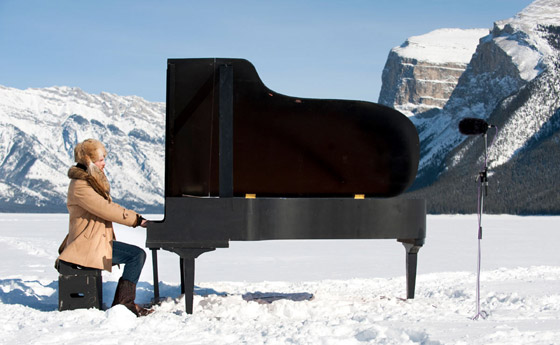Contemplating the American Vernacular
Arts Miami with Anthony Japour
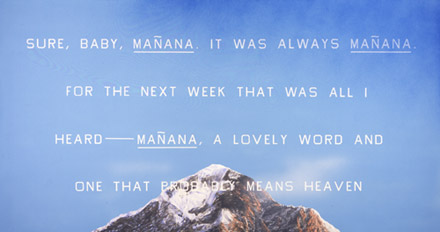
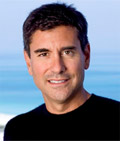
Anthony Japour (AJ) is an independent curator, private art dealer and owner of AJ Japour Gallery. The gallery deals in contemporary art with a focus on the Chinese Contemporary Art Movement and its relationship to the pillars of Western Contemporary Art. Since 2003, AJ has produced numerous art exhibitions and installations in Miami and South Florida. In addition, the Gallery’s secondary mission is to support organizations dedicated to the health, education, and welfare of children. AJ has served on the Fine Arts Board and the Cultural Arts Council of the City of Miami Beach.
“Art Basel-Miami Beach is here five days a year,” said Bonnie Clearwater, executive director and chief curator for Miami’s Museum of Contemporary Art in North Miami, “but MoCA is here all year long.”
Clearwater spoke excitedly about MoCA’s adjacent exhibitions by American artist Ed Ruscha and Ragnar Kjartansson, who represented Iceland at the 2009 Venice Biennale.
Museum of Contemporary Art
770 NE 125th Street
North Miami, FL 33161
www.mocanomi.org
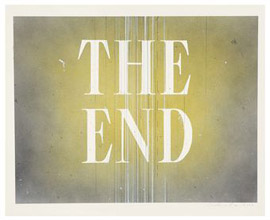
Ed Ruscha: On the Road
On the Road is a collaborative project by artist Ed Ruscha (born 1937 Omaha, Nebraska) and writer Jack Kerouac.
Ed Ruscha is part of the post-pop art generation of artists who began experimenting in the 1960’s with word paintings. His work is strongly linked to the culture of Los Angeles and has been strongly influenced by the Hollywood movie culture. Among his best known series – The End – are paintings with scratches and streaks that are reminiscent of damaged film; that is, when film was still used in the making of Hollywood movies.
In 2009, Ed Ruscha had an important retrospective at the Hayward Gallery, London where I had the opportunity to see the development of his work over five decades. He has moved his work in both directions toward and away from phrasing and single words over the years suggesting a circularity of thought, repetition, and imagination rather than a linear evolutionary path.

While works on canvas are most luminous, Ruscha has produced many original works on paper not only using traditional oil and acrylic paints, but aso experimenting with non-traditional media such as fruit, vegetables, and chocolate.
The current exhibition at MoCA includes six large Ed Ruscha paintings on canvas and 10 drawings on museum board, each taking its text from Kerouac’s 1957 novel, On the Road. Kerouac wrote the novel in 20 days recording his experiences during travels between the US and Mexico.

The text is painted over a mountainous terrain and include such phrases as “SURE, BABY, MAÑANA. IT WAS ALWAYS MAÑANA. FOR THE NEXT WEEK THAT WAS ALL I HEARD— MAÑANA, A LOVELY WORD AND ONE THAT PROBABLY MEANS HEAVEN” and “EVERYTHING TAKES CARE OF ITSELF. I COULD CLOSE MY EYES AND THIS CAR WOULD TAKE CARE OF ITSELF”.
Continuing his exploration of the American vernacular, the Ed Ruscha: On the Road exhibition is at once contemplative and humorous.
Ragnar Kjartansson: Song
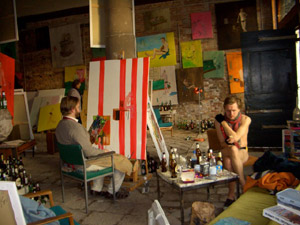
Song is the first solo American museum exhibition for performance artist Ragnar Kjartansson (born 1976, Reykjavik, Iceland) whose video and performance works I first learned about back in 2009 by reading a preview of the 53rd Venice Biennale in Art in America’s International Review.
Throughout the entire Biennale exhibition (June through November) Kjartansson lived at the Michiel dal Brusa, a palazzo on the Canal Grande and pretended to be a painter painting the same model daily for five months. The exhibition was entitled “The End” and consisted of a live performance, a series of paintings and a video and sound installation. Here he painted and repainted the image of a semi-nude model who posed wearing only a swimsuit (despite the cooler temperatures in the Fall when I visited), posing with a beer and a cigarette.
From another part of the Palazzo, one heard a continuous loop of country and blues. Kjartansson, has something of a fascination with words in many of his performance pieces and is why this exhibition fits so well with the Ed Ruscha text paintings.
The exhibition includes the major Kjartansson’s works to date captured in digital format including the humorous work Me and My Mother made first in 2000 while a student and then successively in 2005 and 2010. I learned during the artist’s talk at MoCA that Kjartansson’s parents are actors and that much of his artistic oeuvre is formed around the notion of “pretending”. He said, “life is a fiction, we create our own fictional stories”.
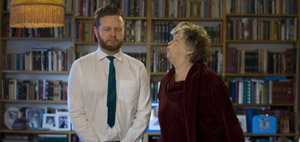
In Song, from which the exhibition gets its title, three of Kjartansson’s nieces, beautifully stylized in the Carnegie Museum’s Hall of Sculpture, repeatedly sing a phrase from an Allen Ginsberg poem, “The weight of the world/ is love”. The running time for this work is 366 minutes and when I visited the exhibition became almost hypnotized by the work having no idea how long we stayed and bit disoriented upon exiting the theatre.
The monumental work of the exhibition is The End, a five channel-video installation set in the stunningly beautiful mountainous landscape of the Canadian Rockies complete with a grand piano and the artist as musician. The End incorporates the music of the 2009 Venice Biennale and in its current expansive installation mirrors the Ed Ruscha’s text paintings next door with the United States Rocky Mountains as its backdrop.
While each of the exhibitions by Ruscha and Kjartansson stand alone, they make a very contemplative pair— video and paintings; music and poetry; of sight and sound—Europe and America.
